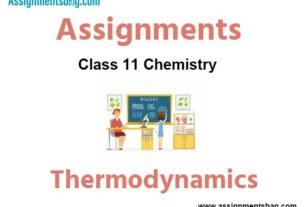Please refer to Assignments Class 11 Biology Biological Classification Chapter 2 with solved questions and answers. We have provided Class 11 Biology Assignments for all chapters on our website. These problems and solutions for Chapter 2 Biological Classification Class 11 Biology have been prepared as per the latest syllabus and books issued for the current academic year. Learn these solved important questions to get more marks in your class tests and examinations.
Biological Classification Assignments Class 11 Biology
Question. Which of the following are not included in the five kingdom system of classification ?
1. Viruses
2. Viroid
3. Lichen
4. Prions
(a) only 1 and 2
(b) only2, 3 and 4
(c) only 1 and 3
(d) All 1, 2, 3 and 4
Answer
D
Question. On the basis of intervening dikaryotic stage which of the following fungal group is odd :
(a) Phycomycetes
(b) Basidiomycetes
(c) Ascomycetes
(d) Club fungi
Answer
B
Question. Select incorrect statement about lichens :-
(a) These are very good pollution indicators
(b) The algal component of lichen is known as phycobiont
(c) The fungal component of lichen is known as mycobiont
(d) The algal component of lichen is known as mycobiont
Answer
D
Question. Fungi constitute a unique kingdom of heterotrophic organisms. About their reproduction which combination is not true :
(a) Fragmentation, Fission, Budding
(b) Conidia, Sporangiospores, Zoospores
(c) Oospore, Ascospore, Basidiospores
(d) Fragmentation, Zoospores, Ascospore
Answer
D
Question. Kingdom fungi classify into various classes based on some parameters except :
(a) Morphology of mycelium
(b) Mode of spore formation
(c) Dikaryophase
(d) Fruiting body
Answer
C
Question. Single celled eukaryotes placed under protista and they link with fungi, plants and animals. Slime moulds are saprophytic protists. What is incorrect about slime moulds :
(a) Body moves along decaying twigs and leaves engulfing organic matter
(b) Under suitable conditions they form plasmodium which may grow and spread over several feet
(c) Under favourable conditions plasmodium differentiate and form fruiting body
(d) Their spores possesses cell wall
Answer
C
Question. Fungi imperfacti are called,
(a) members of phycomycetes
(b) members of ascomycetes
(c) members of basidiomycetes
(d) members of deuteromycetes
Answer
D
Question. Choose the incorrect statement from following:
(a) Dinoflagellates have stiff cellulosic plates on the outer surface
(b) Euglenoids have two flagella, one lies longitudinally and the other transversely
(c) Slime mould spores are dispersed by air currents
(d) In diatoms, the cell walls form two thin overlapping shells, which fit together as in a soap box.
Answer
B
Question. Choose the incorrect statement about ascomycetes :-
(a) Mycelium is branched and septate
(b) Sexual spores are produced endogenously
(c) They have sac like structure in which karyogamy takes place
(d) Reduction division occurs in fruiting bodies and form conidia
Answer
D
Question. Select incorrect statement :-
(a) W.M. Stanly showed that viruses could be crystallized.
(b) In addition to protein coat viruses also contain genetic material that could be either RNA or DNA
(c) The small sub units of capsid called capsomeres
(d) The small subunits of capsid are called peplomers
Answer
D
Question. Which of the following are noncellular organisms that are characterized by having an inert crystalline structure outside the living cell:-
(a) Bacteria
(b) Mycoplasma
(c) Virus
(d) Lichen
Answer
C
Question. Which group of organism is related with basidiomycetes ?
(a) Mushroom, Ustilago, Aspergillus
(b) Puffballs, Agaricus, Aspergillus
(c) Mushroom, Ustilago, Agaricus
(d) Ustilago, Aspergillus, Agaricus
Answer
C
Question. In which class of fungi generally sex organs are absent but plasmogamy is brought about by fusion of two vegetative or somatic cells which have different strains or genotypes.
(a) Phycomycetes
(b) Ascomycetes
(c) Basidiomycetes
(d) Deuteromycetes
Answer
C
Question. Archaebacteria differ from other bacteria in :-
(a) Nucleoid
(b) Composition of cell wall
(c) Composition of cytoplasm
(d) Composition of genetic material
Answer
B
Question. Match the column-I (name of scientist) with column- II (their contribution) and select correct option.
| Column-I | Column-II |
| a. D.J. Ivanowsky | i Discovery of viroids |
| b. Beijerineck | ii Crystallisation of virus |
| c. W.M. Stanley | iii Contagium vivum fluidum |
| d. T.O. Diener | iv Discovery of TMV |
(a) a(iv), b(iii), c(ii), d(i)
(b) a(iv), b(iii), c(i), d(ii)
(c) a(iii), b(iv), c(ii), d(i)
(d) a(ii), b(iii), c(iv), d(i)
Answer
A
Question. Chrysophytes involves :
(a) diatoms
(b) dinoflagellates
(c) desmids
(d) both a and c
Answer
D
Question. Which is incorrect statement ?
(a) The Mycoplasma are organisms that completely lack a cell wall
(b) Mycoplasma can survive without oxygen
(c) Mycoplasma are the smallest living cells.
(d) Mycoplasma are sensitive to penicillin
Answer
D
Question. Which group of organisms is used to make bread and beer ?
(a) Rhizopus
(b) Yeast
(c) Albugo
(d) Neurospora
Answer
B
Question. According to five kingdom system single-celled eukaroytes are placed under :-
(a) Plantae
(b) Monera
(c) Protista
(d) Fungi
Answer
C
Question. Which set of diseases is caused by members of basidiomycetes ?
(a) Rust and smut
(b) Ergot and smut
(c) Ergot and rust
(d) Powdery mildew and rust
Answer
A
Question. Released toxins of which group of protista is the cause of death of other marine animals such as fishes :-
(a) Chrysophytes
(b) Dianoflagellates
(c) Desmids
(d) Euglenoids
Answer
B

